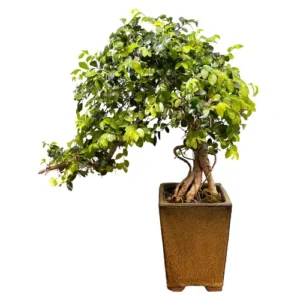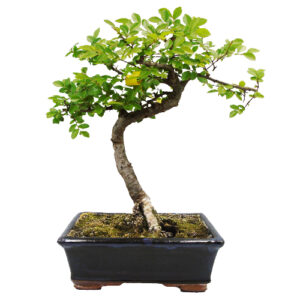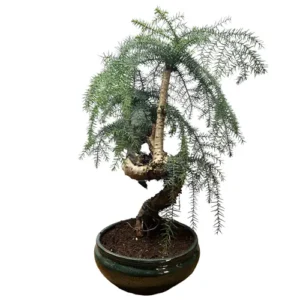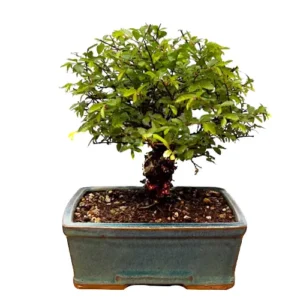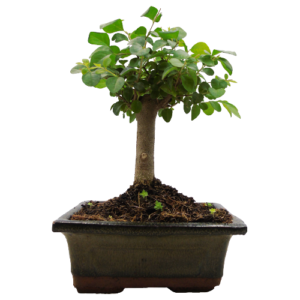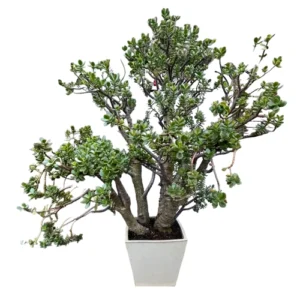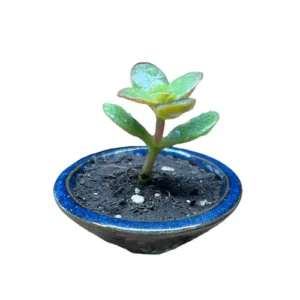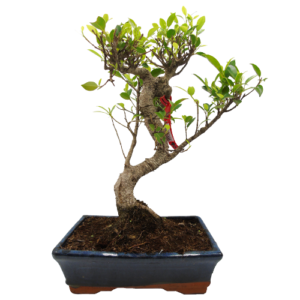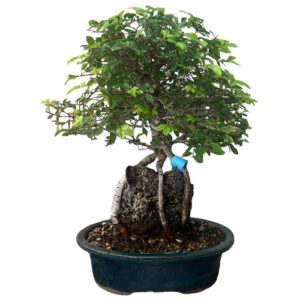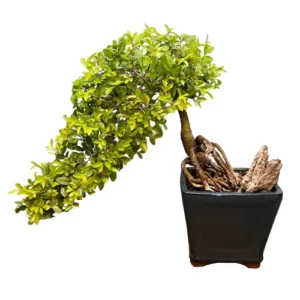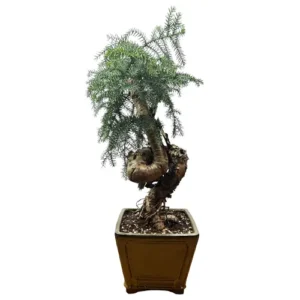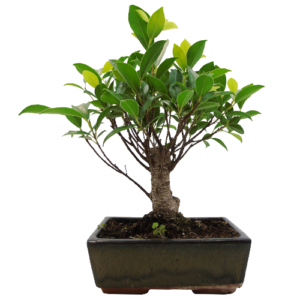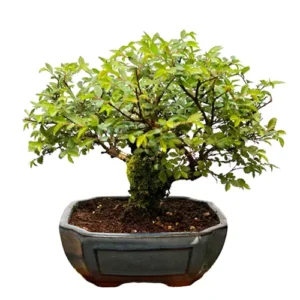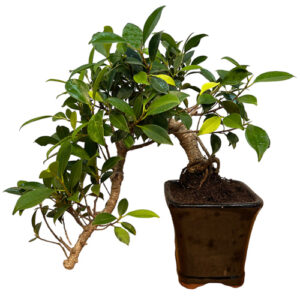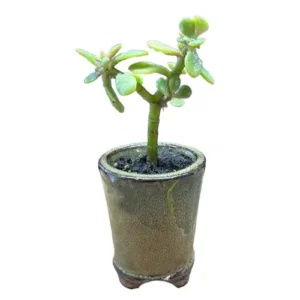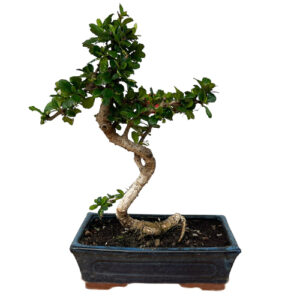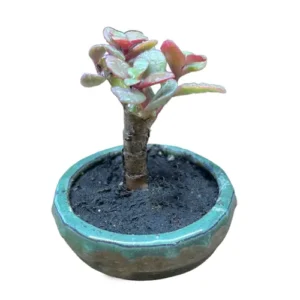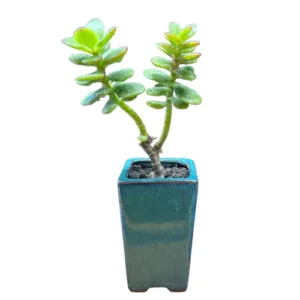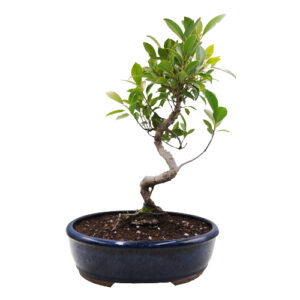Sageretia Theezans
Chinese Bird Plum Bonsai
The sageretia is also known as the sweet plum or bird plum. It is originally from China and used extensively for commercial bonsai production; it’s one of the most popular indoor bonsai and usually recommended to first time bonsai owners. The sageretia has small, oval and light-green leaves, with bark that flakes off in irregular patches to reveal lighter shades underneath. The dappled bark pattern is constantly changing.
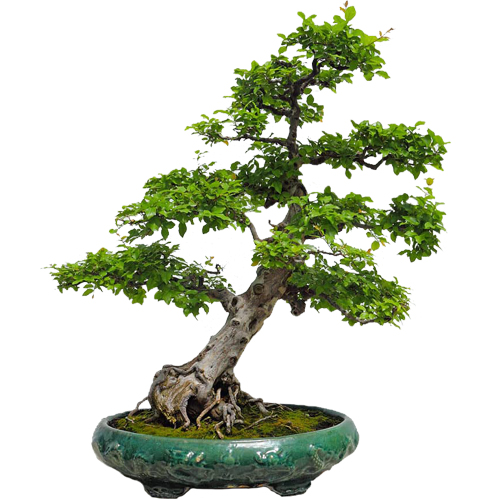
Chinese Bird Plum Bonsai Care Tips
Placement
Choose a bright south or west-facing windowsill but protect from intense sunlight.
The temperature of the room should be kept relatively constant and make sure you keep it away from central heating and cold draughts as this can dry out the root base. They will appreciate being placed outside during the summer to allow for new growth, as long as temperatures do not drop below 15 °C.
During winter, place in the house or a heated conservatory and try to provide temperatures between 12 °C- 22°C.
Watering
There is no definitive guide to watering and it should be conducted on an observational schedule, not a routine. This means that it is important to keep an eye on the moisture levels of the soil to avoid over and under watering, both which can lead to dropping leaves and/or root death. The amount of water a bonsai requires depends on pot size, climate, airflow, soil and tree type so it is best to use your eyes and fingers to assess whether the soil is damp, wet or dry.
If the top inch or so of soil has dried, it is ready to be watered. When you water, ensure an even coverage over the roots and soil, allowing water to flow out from the bottom of the pot to ensure a good soaking.
If you are a first-time bonsai owner, another way to water is by submerging the entire pot in water until the bubbles stop. If you choose this method, be aware that your bonsai may not need watering for another two to four days, but this will depend on the factors mentioned above such as soil type, pot size and climate.
The Chinese bird plum also benefits from slightly higher humidity levels. This can be achieved by using a mister to spray the leaves, as well as placing a gravel tray under the pot to create a more humid microclimate around the tree.
Feeding & Fertilising
Using fertiliser on your Chinese sweet plum will help encourage healthy growth and this should be done periodically from once a week to every two months and only during the growing season. You can start adding Chrysal Liquid Bonsai Feed to your water from March until October and use weekly. Use Naruko Fertiliser Slow Release Bonsai Feed once every one to two months. With Chinese Bird Plum trees, less is more, and we tend to advise using half the recommended dosage to see how your Chinese Bird Plum reacts first.
Pruning & Wiring
Pruning your bonsai is important not only to maintain or create an aesthetic style but to also ensure light and airflow can reach inner leaves and the Sageretia can tolerate pruning of new growth all year round. To do this, use appropriate tools to cut back stems which have grown longer than four leaves, leaving the two leaves which are closest to the stem intact. This will help develop fine ramifications. The best time to prune larger branches is in mid-winter. Cover any larger cut wounds with a sealant to avoid infections.
Training your bonsai using wiring can be conducted any time of the year to the hardened shoots. However, the branches of the Sageretia are very hard and the shape is best produced through pruning.
Repotting
Repotting your tree is an important way to provide a fresh and suitable soil mix and ensure appropriate root health. Repot in early spring. Generally, your Buddhist Pine will need to be repoted once every two years if it is young, while older ones can stay in their pots for longer. However, you should always check if it has become root-bound before you change pots. You can do this by lifting the tree gently out of the pot by the main trunk and examining the root system. You will know it is ready if you can see that the roots are circling around each other and the pot. If, however, they still appear contained in the soil, you should place it back and wait until the following spring to check again.
Trees that are ready for repotting will require root pruning, a suitable new pot and appropriate soil mix.
When repotting, do not cut back the root mass by a large amount, and choose a well-draining soil mix that has a neutral or slightly higher PH value of 5-6 but not over 7. We tend to use a mixture of different speciality bonsai soils on our trees. Every species is different so please contact us for free soil-mix advice or to take advantage of our repotting service.
Bonsai make for a one-of-a-kind indoor plant offering elegance, nature and art all in one minute form. Across an array of exquisite and erudite species, they all demand their own specific care and cultivation needs in order for their beauty to flourish. We have an extensive library of care guides for indoor bonsai trees so you can make an informed and considered choice. It’s not about selecting the perfect bonsai, it’s about selecting the perfect bonsai for you.
Chinese Bird Plum Bonsai - Typical Queries
Can a Chinese Bird Plum bonsai grow indoors?
Yes, a bird plum bonsai can grow indoors, as long as it gets enough light and humidity. It should be placed at a south or west facing window, but protected from intense sunlight. A grow light or a humidity tray can help improve the conditions for the bonsai.
How do you keep a Chinese Bird Plum bonsai tree moist?
To keep a Chinese sweet plum bonsai tree moist, you should water it thoroughly whenever the soil feels dry to the touch. You can also mist the foliage regularly, or use a humidity tray under the pot. Avoid overwatering or letting the bonsai sit in water, as this can cause root rot.
How do I know if my Chinese Bird Plum is overwatered?
Some signs of overwatering your Chinese Bird Plum are yellowing or dropping leaves, soft or mushy stems, and mold or fungus on the soil or the pot. If you notice these symptoms, you should reduce the frequency and amount of watering, and check the roots for any damage.
How often should I fertilize my Chinese Bird Plum bonsai?
You should fertilize your sweet plum bonsai every 1-2 months during the growing season, which is usually from spring to autumn. You can use a slow-release pellet fertilizer, or a liquid fertilizer diluted to half strength. Avoid fertilizing in winter, or when the bonsai is stressed or diseased.
How to propagate a Chinese Bird Plum Bonsai?
There are two main methods to propagate a sweet plum bonsai: seeds and cuttings. Seeds can be collected from the ripe fruits, and sown in moist soil. They should germinate in a few weeks, and then be transferred to a small pot. Cuttings can be taken from healthy branches, and dipped in rooting hormone. They should be planted in moist soil, and kept in a warm and humid place until they root.
What are the common pests and diseases of a Chinese sweet plum bonsai tree?
Some common pests and diseases of a Chinese sweet plum bonsai tree are spider mites, scale insects, mealybugs, aphids, fungal infections, and bacterial infections. You can prevent them by keeping your bonsai healthy, clean, and well-ventilated. You can also treat them with insecticidal soap, neem oil, or fungicide, depending on the type and severity of the problem.

